




 |
 |
 |
 |
 |
DEVELOPMENT |
ONLINE
PROJECTS |
|||||
| Heated Tools for Molten Encaustic Wax Painting | ||||
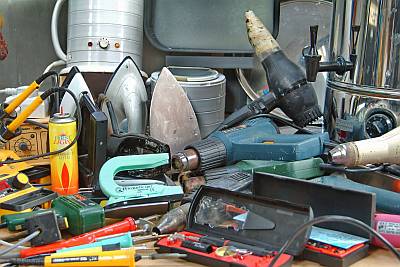 HEATED TOOLS - ELECTRICAL, BATTERY, EVEN GAS! Below are a collection of heated tools, similar to those you might find. These are just collected examples, not recommendations. |
Melting
is the name of this game. Search around for heated tools that could be useful but always consider safety to be the priority!
|
|||
Heated tools come in many shapes and forms. Search out those with the best available temperature controllers - usually built in thermostats. Run them for a period of time whilst you are present, to test out their temperature consistency. Never leave heated tools or devices switched on unattended. Smoking wax is always a sign that you are letting things get too hot! Take Care. |
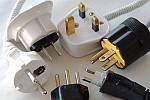 |
PLUGS - the electrical nightmare! But safety
is paramount. |
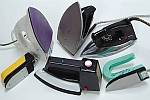 |
Irons - domestic or travel types, come in so many forms these days. The qualities that matter are flat bases free of coatings (no steam holes) and a high quality thermostatic control. The heating power is usually electrical, but battery and gas are also available. There are also the old style solid metal irons that sit on a hot surface to get warmed. |
 |
Battery operated iron. This small iron, usually used in places lacking mains power, like caravans or boat homes, works quite well, but has no variable temperature control. That means it gets to its maximum temperature until the batteries run out. More of a gimmick than a realistic tool, it can have uses, especially for touching up small areas. |
|
A Gas Iron Of course, any open flame close to overheated wax is disaster waiting to strike, so only use this type of iron if you are extremely careful! |
|
The purpose made small encaustic art painting iron is based on the size of a travel iron and manufactured with a polished aluminum base. It contains a high quality thermostat inside. For small to medium sized work and any detailing this is ideal. It is used by all ages across the world, especially inthe card making hobby area, where molten wax interest has been stimulated by fast and fascinating results for all. Also a great palette when used upside down close to your detail working. Molten colour can be taken right up to the work area so a brsuh stroke is only a couple of inches away and does not solidify the wax on the brush! A mini-hotplate can be formed too - ideal for mixing small amounts of wax colour. - some world suppliers |
 Up to Index |
Domestic electric irons are easy to come by and can offer good quality tools for working encaustic wax, especially for larger areas of wax application, where a smaller iron or tool will lose too much heat to the support as it moves over the large areas. Avoid steam irons and search for the best thermostatic control - usually well known brands! |
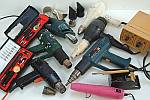 |
Hot Air tools are not just restricted to electric paint strippers or hair dryers. There are now quite a few craft oriented heat tools, often designed for use in activating embossing powders used in rubber stamping work. Also small gas soldering tools and electronic solder stations that use puffing heated air rather than hot metallic tips. |
 |
Powerful heated air flows can be utilised from the main hot air family of Electric Paint Strippers, often called Hot Air Guns. For lesser air flow but with high temperature possibilities try one of the Craft Heat Tools which do not blast so strongly. For less heat but still with very strong airflow power use Salon quality professional hairdryers. |
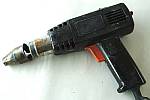 |
A simple Hot Air Gun - this one has seen many years of service and is a Black & Decker model with 2 heat settings of around 300c and 560C with 2 air flow speeds. With the supplied reducing nozzle fitted the air flow focus is increased and more controlled, ideal for the "blowing" part of hot air work Without the nozzle blowing is gentler. |
 |
Variable temperature control in a hot air gun is a valuable advance on set temperatures because it allows far more controlled output during use and can be adjusted at any moment to suit the particular stage of the process of blowing or heating the encaustic wax colours effectively. This Bosch model has a rotary temperature control dial at the back, 2 air flow settings and an optional reduction nozzle. |
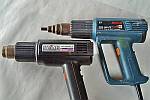 |
The kings of hot air supply have one added feature to enhance total control and that is a rotary air flow roller located in the handle where your fingers will be resting. This means that you can set any temperature on the variable temperature dial located as a circular end disc on these guns. Then alter the air flow to any amount in the low to high range. Several reduction nozzles offer differing focus apertures at the air outlet point. Read more here in the Hot Air Tool page. |
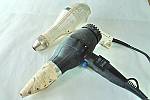 |
Salon professional hair dryers offer strong air flows with lesser temperatures. These are still powerful enough to blow wax about but do not risk burning it. Usually with 2 or 3 heat settings and a similar number of air flow forces. Nozzles are usually flat spreaders (for hair) but hot air ones can be adapted or card ones made provided the highest temperatures are still insufficient to ignite them! |
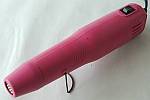 |
Rubber stamping craft heat tools are usually associated with blowing low volume very hot air onto embossing powders to activate these materials. Normally they just have a single switch to operate the unit. This will provide very hot air that is expelled in a gentle stream. These are best used for fusing techniques and for melting applications without disturbing their location through excess blowing force. |
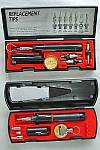 |
Gas powered soldering tools are an interesting potential for small areas. These 2 examples came in nice cases with a selection of tips (see next 2 images below). They are easy to switch on (ignite) and off so, although designed to reach temperatures far higher than needed or wanted in encaustic work, a sensitive use of them through manual control makes them useful for detail areas and has the advantage of no electric cables to trail about. But they can get very hot, so beware! |
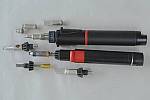 |
Small mobile soldering tools come in a variety of styles and from several manufacturers. The attachments vary from solid tips in differing shapes to hollow tubes that act like tiny hot air guns. The ignition switches are very reliable but it takes a sensitive touch to keep these things at just the right temperature. A bit airbrush like. |
 |
Gas solder tool tips will get too hot if left to attain their natural working temperature. Remember that if you see ANY SMOKE YOU ARE WORKING AT TOO HIGH A TEMPERATURE. Over heated wax fumes and open flame technology just do not mix, so be cautious and use this potential with care and respect. |
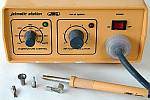 |
The Jetmatic soldering station is an electrically controlled hot air soldering device. Both air temperature and air flow are controllable, but in reality the air flow is so low that it needs to be used on full all the time. A very expensive tool that does not really offer a great deal of useful power in terms of artistic control. |
 Up to Index |
The above hot air soldering station has a selection of tools available as interchangeable tips. The small round reduction nozzle has proved the most useful out of this lot. As already stated, this does not offer great control in artistic work although it is good for creating small round areas like balls or bubble forms. |
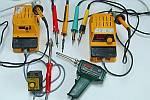 |
Soldering iron tools come in a multitude of shapes and designs with qualities ranging from simple one temperature units to complex electronically controlled stations. But in more recent years many more low heat tools designed to perform specialist functions have joined their ranks. Now quite a few different tools specifically designed and produced for graphical input & wax working are available. |
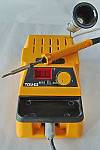 |
This classic electronically controlled soldering station offers the potential for specific tip temperatures to be set and closely maintained by the built-in electronic monitoring. Different manufacturers offer a variety of tip shapes, but since these are made with soldering in mind, most of the tips are solid style chisels of rods. With a little home handiwork they can be adapted to provide flow nibs, heated brush heads, small palette knife ends and so on. They are robust and designed to run all day long. |
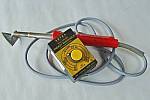 |
Electrical supply temperature controls are basically electronic plugs that are connected to the soldering iron and that then provide a "dimming" or reduction of the power input to the attached unit. The result is similar to a dimmer switch attached to a household light bulb; turn it down and the power reduction creates less light or in our case, less heat! Especially useful for taming higher wattage soldering irons. Also see the "dimmer box" below. |
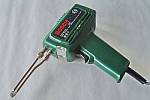 |
Trigger controlled solder guns like this one by Bosch offer a very powerful and fast heat up of the tip blade. Although this models a bit clumsy to hold and to make fine careful strokes with, it does demonstrate the enjoyable trigger control and with a little adaption of the tip could be a very useful palette knife type tool with excellent & powerful manual temperature potentials. |
 |
Button powered soldering irons offer a similar "heats whilst pressed" operation. The small white button is held down and power is connected. When the button is released the power feed is broken, so the heat "freewheels" back down toward the ambient temperature. It means you can "tickle" the temperature or boost it for heavier application strokes. |
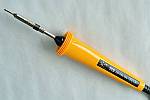 |
Built in electronic controls are the core of some soldering irons. This one, made especially for wax use by Antex, has a small screw operated selection for temperature. Once set, the electronics inside will monitor and maintain the chosen temperature. A little hotter for faster fluid application, a little cooler for slower more viscous flows and sharper, finer lines. |
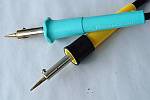 |
Encaustic Stylus units are now specially manufactured specifically for use with encaustic wax colours. The internal windings or temperature generation electrics inside the units are carefully created to provide the correct temperature range for molten wax working. Obviously when the tips are pressed into cold wax to melt it then the units cool slightly and reheating must occur. with smaller tips this happens virtually unnoticed, but large tips cool more quickly and reheat more slowly. |
 |
The Encaustic
Art Stylus has
5 main interchangeable tips, designed for basic graphical input. It
can be used to create spots, lines, wider lines, filling in areas,
shading and mixing colours, smearing, dabbing,
pattern making, hot scraping, melting through layers, in fact all sorts
of creative strokes for small areas or larger on areas that will be
worked more slowly, like graphical drawing and more regular brush painting. |
 |
The tips all fit into the stylus - drawing tip, wire brush head, micro iron, mini iron and also a small round one, but any metal shapes that will fit could be utilised. More information can be found in the stylus page on the hobby section too, and there are supplies here. |
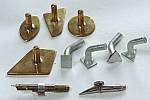 |
Of course, other tips types can be found or made to fit these heating tools. Here are some selected tips that various people have created to meet particular desired results. Remember, small tips will reheat almost without being noticed during use. The larger the tip the slower the reheating, so keep the strokes short, move more slowly or take "reheating" pauses as you work. |
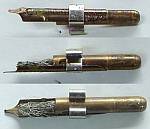 |
For calligraphic input, especially direct onto a clean unwaxed surface, a normal calligraphy nib can be adapted to clip or be bound with wire onto one of the small wire brush heads. The brush fibres are massed at the well hole which feeds the nib, then the wires are saturated with the wax colour desired, forming a supply pool that will last for quite a lot of line length. It can help to increase the width of the nibs split using abrasive paper - this helps increase flow & avoid dry blocks. |
 Up to Index |
An architects line drawing pen tip has been adapted here to fit into the stylus heating unit. The screw adjustment allows a variety of line thicknesses to be formed. The thicker the line the shorter the wax supply in the split nib well will last and also the "fatter" the amount of wax deposited will be. This adaption is one of the most useful we have made for our own uses. |
 |
Hotplates are used in scientific labs, commercial catering food service, domestic food warming, photographic drying and no doubt lots of other things. There are all sorts to be had, some are useful for encaustic work and various methods, others are not. Check out the hotplate section on this site to see some approaches. There are many other approaches not mentioned to date too. |
 |
An iron heated hotplate can only get to a certain size before the iron powering it becomes too weak to keep sufficient heat feeding into the unit. There is also a potential problem with heat distribution. The radiation of heat from the hotplate surface defines the amount of heat loss the hotplate inevitably experiences. These cleverly designed units have their place and can be made by a handy metal worker! |
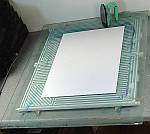 |
Big studio-made hotplates like this one can be made from several smaller hotplate heating surfaces. Here a piece of toughened glass (not regular glass as it will explode!) has bee laid on top of two flat heat units taken out of hostess catering trolleys. The white A2 card scales the size of the elements visible beneath the glass top. Glass is an ideal surface material because it is so easy to clean thoroughly and it does not abrade any dirty residues into the encaustic wax colours during use. |
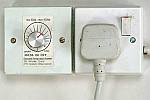 |
This Dimmer Box is
a home made and adapted 1000watt dimmer switch. Any
qualified electrician could make one. In practise
this one shown must have at least 60watts of power being used or it will
burn out - just plug in a light bulb. The great thing is that it can control
any attached item up to 1000watts, so other tools, like hotplates
that get too hot can be "dimmed" into useful temperature ranges. Also see temperature control above. |
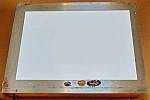 |
Studio made Hotplates can be any size you like. This one was an experimental design using a silicone heat mat, like they use for heating a Jacuzzi for instance. A simple frame work of wood supports a stainless steel top. The white card shown is again an A2 sheet so as to give scale to the proportions of this particular unit. |
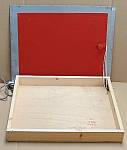 |
Inside you can see the self adhesive heat mat positioned securely onto the stainless steel sheet. The lump to the right is the in built thermostat that monitors and controls the power input for the correct maintenance of the specified temperature. This one is set for 95C which,. after surface heat loss from the oversized A2 metal sheet, results in an realistic operative temperature of around 80 - 85C. The room's ambient temperature affect performance at this level. Cold rooms drain more heat from the surface. |
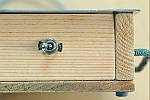 |
The only control offered is an on/off switch. The internal thermostat takes care of the rest. Now you can no doubt understand that if money is not a restrictive factor then a very large hot table could be created, if that was something that might be useful for particular approaches. This hotplate is great for working wax on absorbent papers, water-colour paper, thin card, parchments and the like. |
 |
Domestic food warming trays offer about the best ready made solution for temperature controllable hotplates that can be usefully employed with encaustic practices. The photo obscures the glass topped tray, but scales it. IN food warming this is a 6 plate hotplate with a glass top and a cut out thermostat that is non-adjustable but set to provide a safe upper heat level for food warmth usage. |
 |
The A2+ Ultimate hotplate began as a catering resource for maintaining foods at serveable temperatures. Again, the A2 card scales the unit and fits almost exactly onto the glass surface. However, there are "dead" areas in the electrical heating element's pathway and these are visible in the next image where the log sits and the red marks to the right locate the input of electrical circuit. |
 |
This tools is perfectly suited to many encaustic applications including direct wax melting and therefore use as a palette. For heating palette trays and tins. For colour mixing. For direct application to any thin support material laid on its surface. For loading rollers, maintaining brush & other tools at a ready to use warmth, etc. |
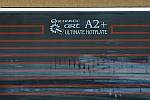 |
Professional quality hotplates will run all day long without error or overheating. The glass surface makes it ideal for cleaning and avoids those nasty dirts that are inevitable with metal surfaces. Try this page by John Buckland for a glimpse into a range of techniques that you can combine into your own styles - possibilities are enormous! |
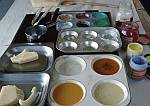 |
The controls allow a heat selection ranging from the ambient temperature to one hot enough to hold metal muffin tins containing wax colour, keeping them in liquid form without overheating. Ideal for colour mixing and general palette use, this A2+ Ultimate Hotplate has been made available in Europe to help develop the potentials of encaustic art in a safe and exciting manner. |
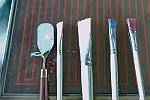 |
Working tools like brushes and palette knives can just rest on this glass hotplate surface where they will stay warm, so that when the moment arises they are ready to be grabbed and instantly used. That in itself is a valuable asset. |
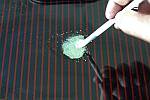 |
Mixing colours with wax direct on the hotplate is also a valuable quality of this product. Any hotplate that can be relied upon to hold a stable and low enough temperature will work for this hot palette need. Keep a small pot of wax medium molten in a stainless measuring cup the pour out a little and dip your brush into pigment to mix fresh hues. |
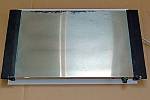 |
Broilking make this one in the USA. The heating device is a roping element, and although thermostatically controllable hotter lines will be evident in the practical use of the unit. Also the stainless steel top can abrade, especially if the pigments are used direct onto its surface, thus tainting the colours. One way round this as a palette is to cover the surface with card, then work off that for direct colour mixing. |
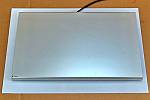 |
An aluminum topped A3 hotplate, again sold into commercial and domestic food warming markets. The aluminum is dirtier than stainless steel, so tainting metallic residues can be a nuisance. This one has no thermostat adjustment although its top temperature is governed, so it can not just go on getting hotter and hotter. Great for mixing in tins. |
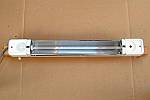 Up to Index |
An infrared heating element such as you will find in a bathroom wall heater has nothing to do with hotplates but is a source of heat. It can be mounted like this one, ont a piece of wood, creating a safe to hold handle. Useful in some instances for fusing together wax colours already applied to a surface, especially a rigid board surface. The advantage over hot air is that there is only heat radiation, no air flows to disturb the placement of the waxes. |
 |
Bulk melting of wax is safest when done in double boilers which use one vessel to contain and heat a jacket of water that surrounds an inner vessel which will contain the wax mix. This way the inner container can never get hotter than the surrounding water, which boils at 100C. So even if it boils madly the wax temperature is still safe. |
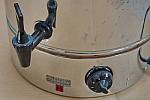 |
A Burco Boiler is usually associated with heating water at commercial or catering events where large amounts are required. Luckily these are supplied with an inner container option, thus forming the desired double boiler and fulfilling the needs of wax blenders. The unit comes with water disposing tap and thermostatic control for the element. |
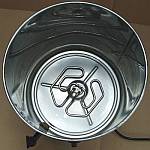 |
Looking inside at the heating element, it is vital NEVER TO PUT WAX DIRECTLY IN HERE. Always use the inner container (shown in the next image) to hold your wax mixes. You can get spares of these, so if you let one formulation store as a cooled mass in one container then you can utilise another for a separate or different mix. It is always important to drain the water out if the unit is not is use. Also know that the inner aluminum containers can show slight whitish "scabs" where the water & aluminum interact. So store dry! |
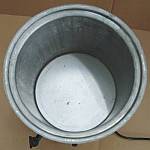 |
The inner aluminum container is adequate to hold a good batch volume of wax. Experience found that one of these half full is more than enough to deal with at a time. Jugs are used to decant the wax once it is molten and mixed. The container is best cleaned out after use, but if you wish the wax can cool inside and remain there for years without issue or problem. A lid is also supplied and will help protect the contents from bugs and dust. It should go without saying by now that ventilation is crucial for health safety, so ensure airflow in your space! |
 |
Electric skillets are a favorite heating container for wax mixing. There are many models to be chosen from but ensure that the thermostat is "tight" and therefore offers pretty accurate control of temperature. This skillet is the one used on the recipe page for making a batch of encaustic wax medium. It works wonderfully. |
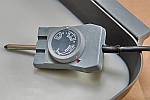 |
The key to safe and effective operation is an accurate thermostat controlling a powerful heating element. This provides fast arrival at the desired temperature combined with the ability to hold that temperature easily. The prong on this control unit plugs into a tube cast on the base of the metal container. It monitors the metal's temperature well. |
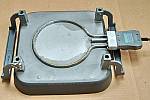 |
The simple single coil heating element is perfectly sufficient to heat and distribute the power effectively into the metal container. The corner supporting feet keep the unit raised off the surface and the handles enable easy movement and pouring, although padded gloves are recommended. Work on a heat resistant surface or use plenty of non-flammable material to cover a more delicate table top. |
 |
Cosmetic wax melting pots are used to heat waxes for hair removal and the like. Also used by candle makers, these units are manufactured to be used in salons and workshops, where they are close to the public. They are well designed and consist of an outer heating well into which a removable metal container is sat. |
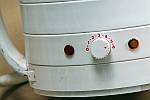 |
The thermostat dial allows a selection of temperatures, so it can be set at hottest to heat up the wax, then redialed to a more moderate temperature that will hold the wax in liquid form, just above the melt point. The indicator light show it is on and if it is in heating mode or not. Plastic outers are easy to clean too. |
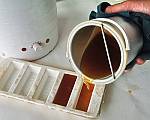 Up to Index |
A plastic handle makes it easy to carry this pot once removed from the heating well. The cross bar is for resting tools on (in salon use) and for pouring the simplest thing is to use a thick rag or padded glove and hold the chamber by its base. The aluminum pots can be left with solid wax inside until the next occasion. These are great for melting down smaller amounts from skillet batches, ready to add colour into using tins on a heated surface like a hotplate with a muffin tin palette. |
YOUR NEXT STOP MIGHT BE THE RECIPE PAGE OR THE HAND TOOLS ... |
|
|